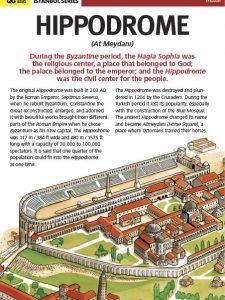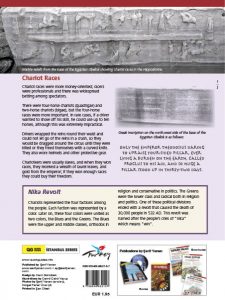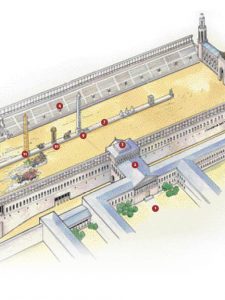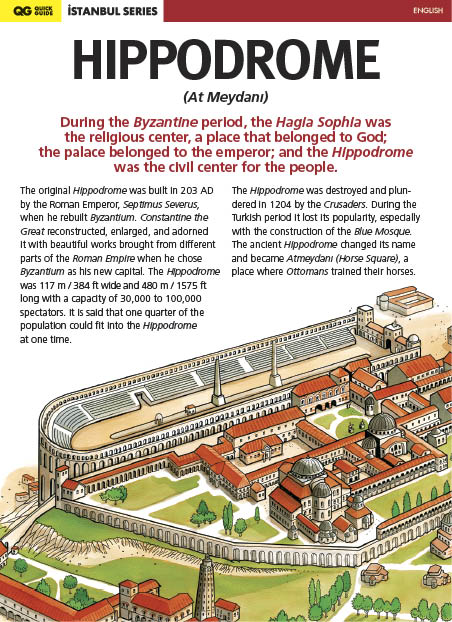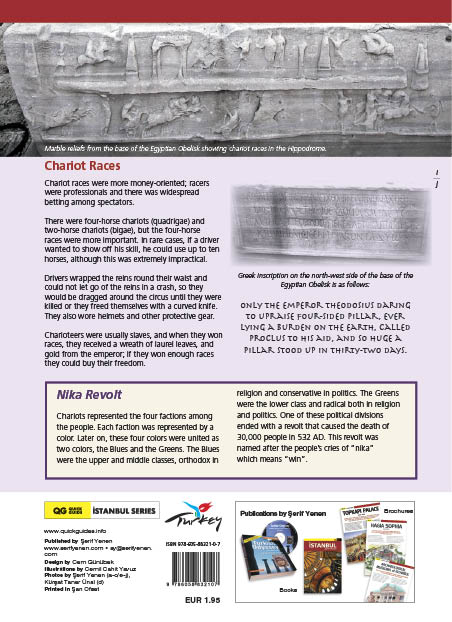Hippodrome in Constantinople
The Hippodrome in Constantinople was an ancient chariot racing track and social center located in the Byzantine capital city of Constantinople (modern-day Istanbul, Turkey). It was one of the most important public spaces in the city and played a significant role in the political, social, and cultural life of the Byzantine Empire.
Hippodrome in Constantinople (Istanbul)
A user friendly and informative Pamphlet with illustrations and plans. Its content is very easy to understand. In addition to general information about the ancient Hippodrome in Constantinople, it shows the photos of all of the major monuments in and around the Hippodrome in Istanbul, Turkey. The illustration shows how it originally looked and how the chariot races took place. A general plan of the surrounding areas will help the reader to get oriented to the site.
Hippodrome in Constantinople Pamphlet
ISBN: 978-605-88321-0-7 Quick Guide Hippodrome (English, Turkish)
Available at Museum Shops in Turkey
Hippodrome in Constantinople
The 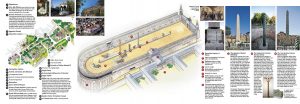 was originally constructed during the reign of the Roman Emperor Septimius Severus in the 3rd century AD. However, its most significant modifications and expansions were made by various Byzantine emperors, particularly during the 4th and 5th centuries. The track itself was a long and narrow arena surrounded by tiers of seating, allowing spectators to watch chariot races and other events.
was originally constructed during the reign of the Roman Emperor Septimius Severus in the 3rd century AD. However, its most significant modifications and expansions were made by various Byzantine emperors, particularly during the 4th and 5th centuries. The track itself was a long and narrow arena surrounded by tiers of seating, allowing spectators to watch chariot races and other events.
Chariot racing was a popular sport in the Byzantine Empire, and the Hippodrome was the primary venue for these races. The four main factions or teams associated with the chariot races were the Blues, Greens, Reds, and Whites, each with their own fanatical supporters. These factions often had strong political and social affiliations, leading to intense rivalries and even riots at times.
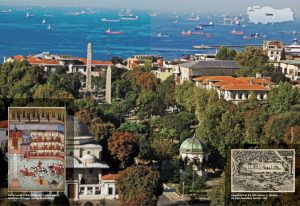 In addition to chariot races, the Hippodrome was also used for various public gatherings, ceremonies, and events. It was a space where emperors addressed the populace, where important diplomatic meetings took place, and where public trials and executions occurred. The Hippodrome played a central role in shaping the cultural and political life of Constantinople.
In addition to chariot races, the Hippodrome was also used for various public gatherings, ceremonies, and events. It was a space where emperors addressed the populace, where important diplomatic meetings took place, and where public trials and executions occurred. The Hippodrome played a central role in shaping the cultural and political life of Constantinople.
Over time, the Hippodrome underwent several changes and reconstructions due to fires, earthquakes, and renovations. However, its prominence began to wane after the Fourth Crusade in the early 13th century, when the city was sacked and many of its treasures, including the racing quadriga statue, were looted.
Today, little remains of the original Hippodrome, as it was largely dismantled and repurposed during the Ottoman period. However, some of its architectural elements, such as the Egyptian Obelisk (the Obelisk of Theodosius) and the Serpent Column, can still be seen in the Sultanahmet Square (formerly known as the Hippodrome Square) in Istanbul.


